|

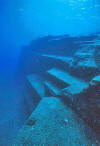

Terraces
and steps: perspectives of the south face of the main
monument, Yonaguni. |


Terraces
and steps: prehistoric rock-hewn structures at
Sacsayhuaman and nearby Qenko in the high Andes
mountains of Peru
.
|
|

Turtle
figure carved into the top of the eastern side of the
main monument.
|


Two
views of the "Basin", a pool-like structure near the
apex of the main monument. It features a right-angled
internal corner, sheltered by surrounding elevations.
|
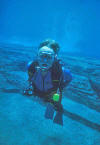

Graham Hancock diving in the "Basin" at Yonaguni. |
|
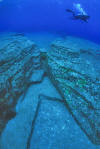
View of
the internal right-angle of the Basin. It is difficult
to see how such a feature in such a protected setting
could have been produced solely by natural forces such
as waves or tidal action
.
|
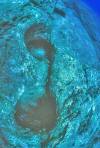
A series
of three vertical holes run in alignment along the
Basin's straight edge. Some geologists have described
them as pot-holes, which they may well be. However their
direct and immediate association with another curious
feature - the Basin itself - should force us to consider
other possibilities as well. |
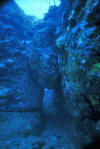
Megalithic entrance tunnel leading to parallel megaliths
.
|
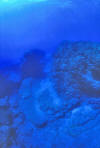
Curious
feature, close to parallel megaliths, with an apparent
curving sloped stone path flanked by parallel curving
walls
.
|
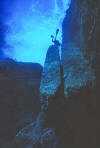
Parallel
megaliths with diver for scale.
|
|
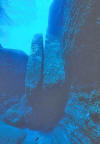
Parallel
megalithic blocks oriented east to west and lying at the
north-west corner of the main monument
.
|
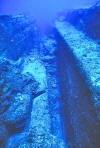
Second
area of terracing half a kilometer south of the main
monument. Found at the base of a sheltered east-west
defile and at a depth of 27 meters, it could not have
been subjected to the "wave and tidal forces" that some
geologists believe were responsible for the Yonaguni
anomalies. |


Two-ton
megalith surmounting a carved platform 300 meters to the
east of the main monument
.
|
|
|
|
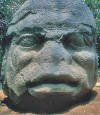
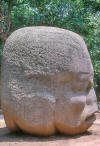
Megalithic carved stone head, La Venta, Gulf of Mexico.
|

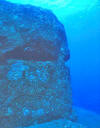
Now
submerged beneath 18 metres of ocean could this
underwater apparition off Yonaguni be a much eroded
megalithic carved head left behind by some lost
antediluvian culture? Or is it just another one of the
apparently limitless "freaks of nature" that geologists
wish to persuade us have somehow managed to accumulate
around one tiny island in the extreme south-west of
Japan? The "Face", as it is known to local divers, and
the "Stone Stage" of which it is an integral part, are
located off the south coast of Yonaguni 2 kilometers to
the east of the main monument. |

The Face
and Stone Stage in their surroundings
.
|
|
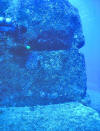
The right
eye of the Face with diver for scale. The Face looks due
south. |
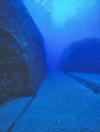
Rock-hewn
avenue beside the Stone Stage
. |
|

Rock-hewn
rectlinear structure and megalithic 'paving' close to
the Stage
.
|

This
wider view shows the Face and the Stage to be set
amongst a complex of rectilinear structures
. |